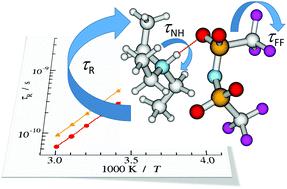当前位置:
X-MOL 学术
›
Phys. Chem. Chem. Phys.
›
论文详情
Our official English website, www.x-mol.net, welcomes your
feedback! (Note: you will need to create a separate account there.)
Insights into the translational and rotational dynamics of cations and anions in protic ionic liquids by means of NMR fast-field-cycling relaxometry
Physical Chemistry Chemical Physics ( IF 2.9 ) Pub Date : 2021-1-13 , DOI: 10.1039/d0cp05440b Viviane Overbeck 1, 2, 3, 4, 5 , Henning Schröder 2, 4, 6, 7 , Anne-Marie Bonsa 1, 2, 3, 4, 5 , Klaus Neymeyr 2, 4, 6, 7 , Ralf Ludwig 1, 2, 3, 4, 5
Physical Chemistry Chemical Physics ( IF 2.9 ) Pub Date : 2021-1-13 , DOI: 10.1039/d0cp05440b Viviane Overbeck 1, 2, 3, 4, 5 , Henning Schröder 2, 4, 6, 7 , Anne-Marie Bonsa 1, 2, 3, 4, 5 , Klaus Neymeyr 2, 4, 6, 7 , Ralf Ludwig 1, 2, 3, 4, 5
Affiliation

|
Understanding the translational and rotational dynamics of cations and anions in hydrogen bonded protic ionic liquids (PIls) is still a challenge. In this study, we determine self-diffusion coefficients and rotational correlation times of both ions in triethylammonium based PILs by means of NMR Fast-Field-Cycling (FFC) relaxometry. Global fits of 1H and 19F nuclear magnetic relaxation dispersion (NMRD) curves allowed proper separation into intra and inter molecular relaxation rates for both NMR sensitive nuclei and thus a reliable description of translational and rotational motion for both ions individually. The diffusion coefficients of the cations are in the order of 6 × 10−11 m2 s−1 at room temperature and about 50 per cent larger than those of the anions. The diffusion coefficients of cations and anions in both PILs were compared with those we derived from applying an universal dispersion power law and those known from pulsed field gradient (PFG) NMR studies. Considering the Nernst–Einstein equation, molar conductivities were calculated from cationic and anionic diffusion coefficients and related to directly measured molar conductivities, allowing the determination of the degree of dissociation. The rotational correlation times τR ranging from 50 ps up to 2 ns as a function of temperature were compared with those obtained from high-field NMR quadrupolar relaxation time measurements addressing explicitly the rotation of the NH vector and giving insights into the acidic proton mobility. The Stokes–Einstein and Stokes–Einstein–Debye relations were applied to relate the diffusion coefficients and rotational correlation times to the macroscopic bulk viscosity. The results were also discussed with respect to the archetypical PIL ethylammonium nitrate.
中文翻译:

通过NMR快速场循环弛豫法洞察质子离子液体中阳离子和阴离子的平移和旋转动力学
理解氢键质子离子液体(PIls)中阳离子和阴离子的平移和旋转动力学仍然是一个挑战。在这项研究中,我们通过NMR快速场循环(FFC)弛豫法确定基于三乙铵的PIL中两种离子的自扩散系数和旋转相关时间。的全局拟合1 H和19 ˚F核磁弛豫分散体(NMRD)曲线允许适当分离成帧内和帧间分子松弛速率两者NMR敏感核,因而平移和旋转运动的,用于单独地两种离子的可靠描述。阳离子的扩散系数为6×10 -11 m 2 s -1在室温下,比阴离子大50%。将两种PIL中阳离子和阴离子的扩散系数与我们根据通用色散功率定律得出的扩散系数以及从脉冲场梯度(PFG)NMR研究获知的扩散系数进行了比较。考虑到Nernst-Einstein方程,可根据阳离子和阴离子扩散系数计算摩尔电导率,并与直接测量的摩尔电导率相关,从而可以确定解离度。旋转相关时间τ ř比较了从50 ps到最大2 ns随温度变化的温度范围,与从高场NMR四极弛豫时间测量获得的结果进行了比较,这些测量结果明确解决了NH向量的旋转问题,并提供了对酸性质子迁移率的见解。应用斯托克斯-爱因斯坦和斯托克斯-爱因斯坦-德拜关系将扩散系数和旋转相关时间与宏观体积黏度联系起来。还讨论了关于原型PIL硝酸乙基铵的结果。
更新日期:2021-01-22
中文翻译:

通过NMR快速场循环弛豫法洞察质子离子液体中阳离子和阴离子的平移和旋转动力学
理解氢键质子离子液体(PIls)中阳离子和阴离子的平移和旋转动力学仍然是一个挑战。在这项研究中,我们通过NMR快速场循环(FFC)弛豫法确定基于三乙铵的PIL中两种离子的自扩散系数和旋转相关时间。的全局拟合1 H和19 ˚F核磁弛豫分散体(NMRD)曲线允许适当分离成帧内和帧间分子松弛速率两者NMR敏感核,因而平移和旋转运动的,用于单独地两种离子的可靠描述。阳离子的扩散系数为6×10 -11 m 2 s -1在室温下,比阴离子大50%。将两种PIL中阳离子和阴离子的扩散系数与我们根据通用色散功率定律得出的扩散系数以及从脉冲场梯度(PFG)NMR研究获知的扩散系数进行了比较。考虑到Nernst-Einstein方程,可根据阳离子和阴离子扩散系数计算摩尔电导率,并与直接测量的摩尔电导率相关,从而可以确定解离度。旋转相关时间τ ř比较了从50 ps到最大2 ns随温度变化的温度范围,与从高场NMR四极弛豫时间测量获得的结果进行了比较,这些测量结果明确解决了NH向量的旋转问题,并提供了对酸性质子迁移率的见解。应用斯托克斯-爱因斯坦和斯托克斯-爱因斯坦-德拜关系将扩散系数和旋转相关时间与宏观体积黏度联系起来。还讨论了关于原型PIL硝酸乙基铵的结果。











































 京公网安备 11010802027423号
京公网安备 11010802027423号